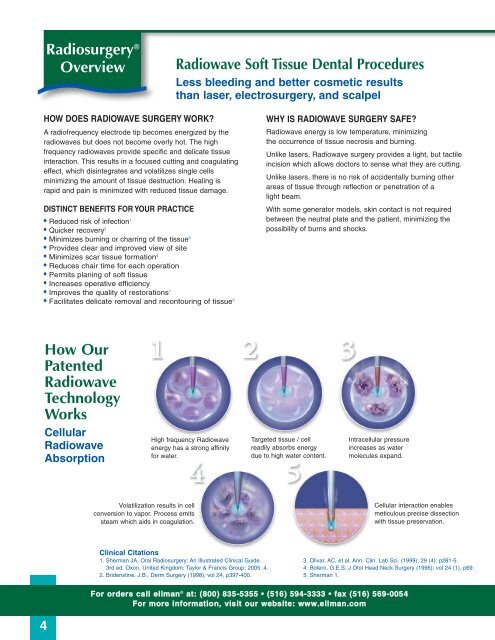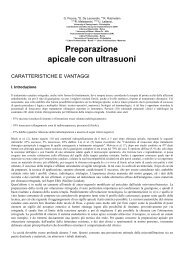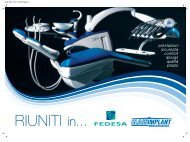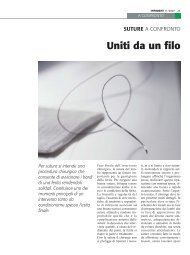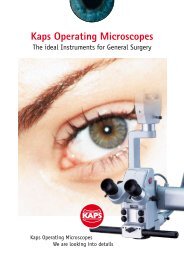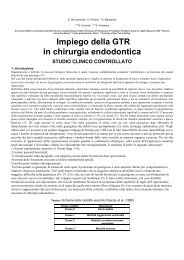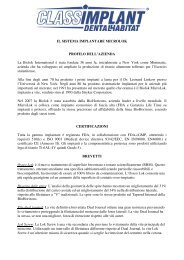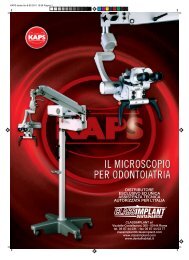Dentistry Catalog
Dentistry Catalog
Dentistry Catalog
Create successful ePaper yourself
Turn your PDF publications into a flip-book with our unique Google optimized e-Paper software.
Radiosurgery ®<br />
Overview<br />
Radiowave Soft Tissue Dental Procedures<br />
Less bleeding and better cosmetic results<br />
than laser, electrosurgery, and scalpel<br />
HOW DOES RADIOWAVE SURGERY WORK?<br />
A radiofrequency electrode tip becomes energized by the<br />
radiowaves but does not become overly hot. The high<br />
frequency radiowaves provide specific and delicate tissue<br />
interaction. This results in a focused cutting and coagulating<br />
effect, which disintegrates and volatilizes single cells<br />
minimizing the amount of tissue destruction. Healing is<br />
rapid and pain is minimized with reduced tissue damage.<br />
DISTINCT BENEFITS FOR YOUR PRACTICE<br />
• Reduced risk of infection 1<br />
• Quicker recovery 2<br />
• Minimizes burning or charring of the tissue 3<br />
• Provides clear and improved view of site<br />
• Minimizes scar tissue formation 4<br />
• Reduces chair time for each operation<br />
• Permits planing of soft tissue<br />
• Increases operative efficiency<br />
• Improves the quality of restorations 1<br />
• Facilitates delicate removal and recontouring of tissue 5<br />
WHY IS RADIOWAVE SURGERY SAFE?<br />
Radiowave energy is low temperature, minimizing<br />
the occurrence of tissue necrosis and burning.<br />
Unlike lasers, Radiowave surgery provides a light, but tactile<br />
incision which allows doctors to sense what they are cutting.<br />
Unlike lasers, there is no risk of accidentally burning other<br />
areas of tissue through reflection or penetration of a<br />
light beam.<br />
With some generator models, skin contact is not required<br />
between the neutral plate and the patient, minimizing the<br />
possibility of burns and shocks.<br />
How Our<br />
Patented<br />
Radiowave<br />
Technology<br />
Works<br />
Cellular<br />
Radiowave<br />
Absorption<br />
High frequency Radiowave<br />
energy has a strong affinity<br />
for water.<br />
Targeted tissue / cell<br />
readily absorbs energy<br />
due to high water content.<br />
Intracellular pressure<br />
increases as water<br />
molecules expand.<br />
Volatilization results in cell<br />
conversion to vapor. Process emits<br />
steam which aids in coagulation.<br />
Cellular interaction enables<br />
meticulous precise dissection<br />
with tissue preservation.<br />
Clinical Citations<br />
1. Sherman JA. Oral Radiosurgery: An Illustrated Clinical Guide. 3. Olivar, AC, et al, Ann. Clin. Lab Sci. (1999); 29 (4): p281-5.<br />
3rd ed. Oxon, United Kingdom: Taylor & Francis Group; 2005: 4. 4. Botero, G.E.S, J Otol Head Neck Surgery (1996); vol 24 (1), p69.<br />
2. Bridenstine, J.B., Derm Surgery (1998); vol 24, p397-400. 5. Sherman 1.<br />
For orders call ellman ® at: (800) 835-5355 • (516) 594-3333 • fax (516) 569-0054<br />
For more information, visit our website: www.ellman.com<br />
4


